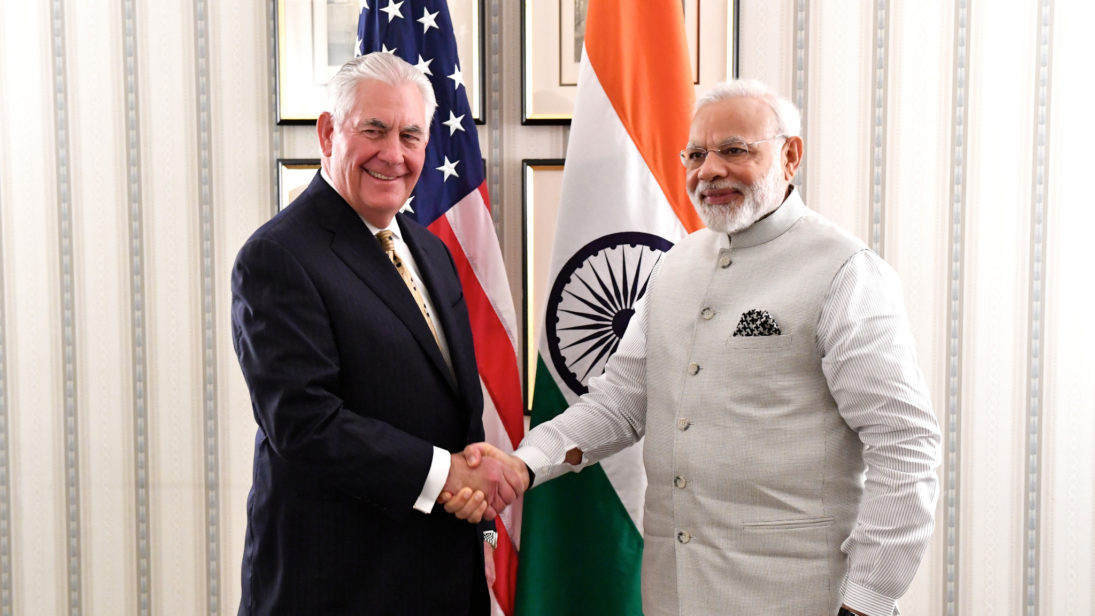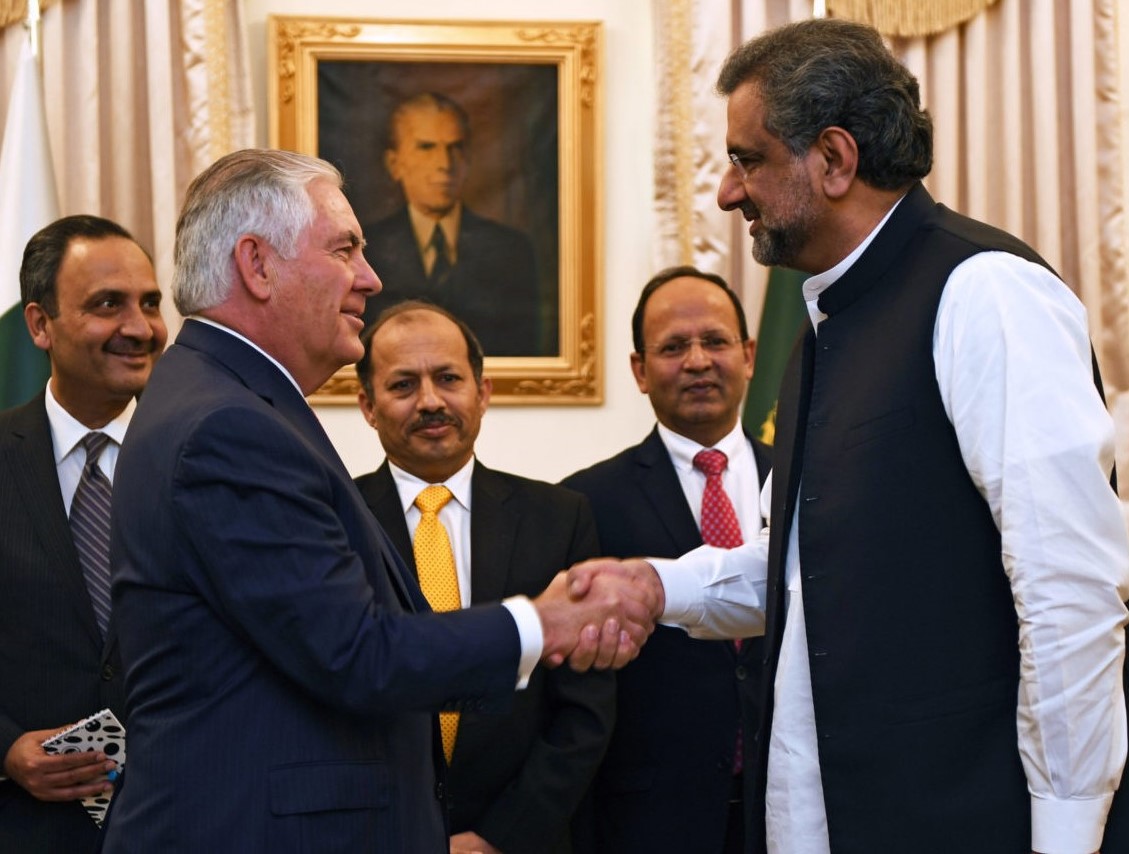
Dialogue between the United States and India recently has been dominated by regional developments, in large part due to U.S. President Donald Trump’s new South Asia policy and his call for an increased commitment by New Delhi to ensure stability in Afghanistan. At the same time, during a speech last week at the Center for Strategic and International Studies (CSIS) in Washington, U.S. Secretary of State Rex Tillerson indicated that the pursuit of stability in the Indo-Pacific will be another point of convergence for India and the United States.
In light of these developments, Secretary Tillerson’s visit to New Delhi this week will focus on regional issues. Given India’s own stake in Afghanistan and its concerns about Pakistan, India will likely seek to clarify the United States’ intentions in the region. Meanwhile, if Tillerson’s recent speech is indicative of U.S. priorities, the United States may press for an expanded partnership with India in the Indo-Pacific. At the same time, though the bilateral defense relationship may not see any significant developments during this visit, the issue is sure to come up for discussion between Tillerson and other high-level officials.
While the Tillerson visit has the potential to clarify Indo-U.S. cooperation in Asia, whether the two sides manage to agree on a long-term roadmap for their partnership remains to be seen.
Towards Stability in Afghanistan and the Indo-Pacific
During U.S. Secretary of Defense James Mattis’ visit to India last month, India rejected sending troops to Afghanistan while remaining open to expanding development aid, medical assistance, and capacity-building efforts. New Delhi is also looking for greater involvement in the security domain by increasing training and support to the Afghan National Army and signed a Memorandum of Understanding with Kabul last month to train Afghan police and security forces in India. Interestingly, President Ashraf Ghani is in India at the same time as Secretary Tillerson, presenting an opportunity for India, the United States, and Afghanistan to move forward with a trilateral framework to bring stability to the war-torn country.
Tillerson will likely face some tough questions from his hosts in New Delhi on the re-hyphenation of U.S. relations with India and Pakistan, something strongly detested by India. India will seek clarity on the Trump administration’s Pakistan policy, as there have been contradictory messages. While unveiling his South Asia policy, President Trump made some tough statements, calling Pakistan out on its support for terror groups. However, Trump was all praise for Pakistani leadership recently following the rescue of an American-Canadian couple and their three children held by the Haqqani Network. Secretary Tillerson travels to New Delhi from Islamabad and there will be considerable interest in the message he delivers to Pakistan on the issue of its continued support to terrorist elements. He has said that he will ask Pakistan “to take decisive action against terrorist groups based within their own borders that threaten their own people and the broader region.”


Meanwhile, the Indo-Pacific appears to be at the forefront of the United States’ agenda. During his speech at CSIS last week, Tillerson commended New Delhi for rising “responsibly” while emphasizing that China has “at times undermin[ed] the international rules-based order.” While articulating a vision for a strong Indo-U.S. partnership in the region, he indicated that India and the United States—with their “shared values and vision for global stability, peace, and prosperity”—would collaborate with democratic allies such as Japan and Australia to construct a rules-based order in the Indo-Pacific. These statements are being read in India as support for its points of contention with China—a desirable position given the strained state of Sino-Indian ties after the Doklam standoff.
In the context of the Indo-Pacific, India will be keen to know how the United States plans to counter China’s One Belt One Road (OBOR) initiative. Secretary Mattis has already endorsed India’s apprehensions over a Chinese infrastructure project passing through territory it disputes with Pakistan. In his speech at CSIS, Tillerson expressed concern over Chinese financing mechanisms for OBOR, stating this will leave countries saddled with “enormous levels of debt.” He added: “We think it’s important that we begin to develop some means of countering that with alternative financing measures, financing structures.”
India would likely be open to any opportunity to cooperate with the United States and regional partners, especially Japan, on infrastructure development in South Asia. There seems to be some momentum in this direction. Last month, the United States and Nepal signed a $500 million compact agreement for energy and road transportation infrastructure development. Though this is the first such agreement for the United States in South Asia, this kind of venture is of keen interest to New Delhi. Infrastructure development initiatives also present an opportunity to bring Japan on board. Tokyo is already investing in infrastructure development in India’s Northeast region and has expressed general enthusiasm for deepening trilateral cooperation with the United States and India. If India, the United States, and their mutual allies cooperate on this issue, they could offset the negative fallout of OBOR in India’s neighborhood.
Bilateral Defense Cooperation
On the bilateral front, Secretary Tillerson will likely follow up with India on the defense cooperation initiatives discussed during Secretary Mattis’ visit. However, little progress is expected. The United States has repeatedly renewed its offer to build F-16 and F-18 fighter jets in India as well the sale of 22 Guardian maritime drones. While India is currently evaluating the proposal on the drones, the fighter jet offer is part of a much bigger deal to select a single engine fighter jet being processed by the Indian Air Force (IAF). As such, an announcement on the fighter jet proposal is unlikely, since the IAF is expected to issue a Request for Information (RFI) within the next couple of months under the newly promulgated Strategic Partnership guidelines. However, Tillerson may formally make an announcement on U.S. intent to sell two Intelligence, Surveillance, Target Acquisition and Reconnaissance (ISTAR) aircraft from Raytheon through the inter-governmental route.
However, from Washington’s perspective, any movement in defense cooperation and technology transfer is contingent upon India quickly concluding the two remaining foundational agreements, the Communications Compatibility and Security Agreement (COMCASA) and Basic Exchange and the Cooperation Agreement for Geospatial Information and Services Cooperation (BECA). COMCASA is particularly important under U.S. laws for the transferal of critical technologies and platforms. So, while wide-ranging discussions on expanding defense purchases and co-development continue, the finalization will hinge on the conclusion of these agreements or finding a way around them.
This trip presents an avenue for New Delhi to gain a clearer picture of the United States’ true regional intentions in Afghanistan, Pakistan, and the Indo-Pacific while strengthening the partnership as a whole. Secretary Tillerson will have an opportunity to present the United States’ evolving strategic vision in Asia, which will, in turn, help India refine its own path forward with the United States.
***
Image 1: U.S. Department of State via Flickr
Image 2: U.S. Embassy Pakistan via Flickr(cropped)


